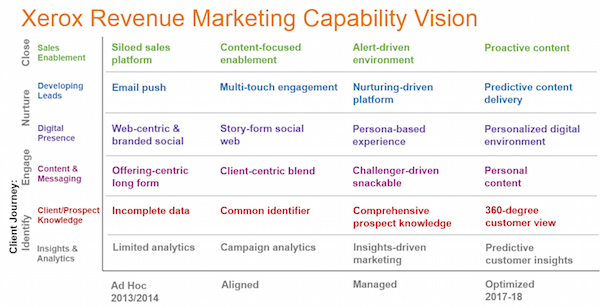The following is a guest Q&A with Chris Bledsoe, VP of marketing technology at Fool.com, conducted by Diana Smith, director of marketing at Segment. Disclosure: Segment gets a shout out in one of Chris’s answers, but the rest of the Q&A is vendor agnostic.
Alongside the explosion of marketing technology, we’re also seeing some new titles cropping up in big organizations to handle this ecosystem. One is VP of marketing technology. Since this type of role is so new, we took some time to sit down with Chris Bledsoe, VP of marketing technology, at Fool.com, a publishing company dedicated to helping the world invest smarter.
Chris has an interesting journey. He started as a software engineer, but his enthusiasm for growing businesses and personal hack projects kindled his interest in marketing. He started the first marketing technology group at Fool.com, where for the first time, engineers were embedded in the marketing team to help empower them to use the systems they need to be more efficient. Chris muses on his role, and what would lead an engineer this direction.
1. So what does being a “VP of marketing technology” really mean? How did that role develop and what are you responsible for?
As a VP of marketing technology at Fool.com, I lead the strategy for how our marketing team brings on new technology, develop the implementation roadmap, and manage requests for marketing managers across the organization.
Rather than having an isolated group of engineers support marketing requests part-time, we’ve embedded our technical team into the marketing department. This has been a huge win for us in terms of providing better service to our marketers and increasing efficiency across the organization. The marketing tech team I lead reports to our technology department, and I report to the chief digital officer, who oversees our FoolMakers marketing group.
Rather than having an isolated group of engineers support marketing requests part-time, we’ve embedded our technical team into the marketing department.
Day to day, this means I work closely with marketing managers to determine what software needs they have and how we can solve them. These conversations might lead to building solutions internally or evaluating and implementing third-party tools and services. I take all of their requests and prioritize our tech team’s backlog to make sure we are working on the highest impact requests and delivering the most value for our marketing managers.
The role evolved in an interesting way. I was originally a software developer at Fool.com, then moved into a business position, and eventually became a marketing manager. As I worked with the tools that our marketers were working with, I noticed opportunities to improve the technology stack and the marketers’ workflows. Eventually that led me into my current role as VP of marketing technology.
2. How did marketing get engineering projects done before your group joined the marketing organization?
Prior to the existence of our marketing technology team, when someone in the company had a marketing technology need, they would go to the CTO and make a case for solving that need. Examples of these requests include integrating with an email service provider, developing interactive video plugins for a video sales letter, or even designing a welcome campaign email series.
If the request for a particular tech project was approved, an engineering team was formed to solve that task. After the task was completed, the tech team would disband and the developers would move onto other projects.
Moving to an embedded engineering team has allowed us to build better workflows and create efficiencies for our marketers.
Moving to an embedded engineering team has allowed us to more closely align our marketing tech stack with our other tech systems, build better workflows, and create efficiencies for our marketers. It’s also easier to prioritize projects, because we are all working towards the same top-level goals.
Since this was so successful, we’ve added resources over time, and we’re scaling out the embedded team concept to other areas of the company outside of marketing.
Since this was so successful, we’re scaling out the embedded team concept to other areas of the company outside of marketing.
3. What skills are needed to work in marketing technology? What interests would lead an engineer this direction?
Since the role is new and evolving, a marketing technologist means a lot of different things to a lot of different people. The role varies widely but usually involves some mix of marketing, analytics, and engineering. The deeper the understanding of each of these areas is, the more valuable the marketing technologist can be.
The role varies widely but usually involves some mix of marketing, analytics, and engineering.
For many companies, marketing technologists are marketers who have a basic understanding of technology. For other companies, they are software developers with marketing backgrounds.
I’ve been a full-time developer, written marketing copy, optimized landing pages for conversion, and even been a marketing manager before. This background and experience has allowed me to better understand our marketing manager’s needs and design better systems and automation around their workflows.
As to what interests would lead an engineer in this direction, I’d say a general interest and appreciation of business and marketing, as well as a desire to scale a business using technology. Since I started both writing code and running my first Internet business at a very young age, this field was sort of natural for me.
4. What are your favorite marketing tech tools?
There are many awesome tools in the marketing tech space right now. I’m sure you’ve seen this blog’s marketing technology landscape. It’s fascinating how quickly this space is growing, and I love that there are always new tools to play with.
Here are a few of my favorite marketing tech tools right now:
Segment — We use Segment as our core infrastructure for collecting analytics events and sending them off to our other tools. It’s much easier to service our marketing managers’ requests, because once we implemented Segment, we just have to click a few buttons to install new tools. We also use their software to transform and load this data into Amazon Redshift, so we can run custom queries on our campaigns. I often browse their integrations page to check out the latest martech tools. That’s how I found Keen and Periscope.
Keen.io — Keen is awesome for building custom dashboards and analyses. They don’t require you to know SQL, but you can easily drag and drop your data into super-granular charts and reports. Keen is particularly helpful for publishers who are trying to measure attribution, an ever evolving challenge.
Periscope.io — We use Periscope on top of Segment SQL to easily query our analytics data and create dashboards to display to the team. Periscope is super fast for querying because they cache your data on their servers. When you’re working with a lot of data, like we are, this speed makes a difference.
Google Analytics — While not particularly new or novel, GA gets the job done for answering most marketing questions. It’s great for understanding the traffic coming to your site, analyzing campaigns, and understanding landing page conversions.
5. Now that you’ve got the Marketing Technology team running, what is your next goal?
I’m really excited to bring data democratization to Fool.com. To me, data democratization means bringing self-service data and data tools to teams around the company. Achieving easy access to data will empower all of our employees to better understand our customers and ultimately deliver better solutions to them.
To me, data democratization means bringing self-service data and data tools to teams around the company.
When I started, 7 years ago, our employees had to go to a business intelligence analyst, request data, wait for the analyst to pick up the request, and then get their data. This worked fine, but it was too slow for us. The more we can empower our internal teams to have quicker access to data and to find their own insights in the data without always needing our BI team, the faster we can move.
Thanks, Chris and Diana!



